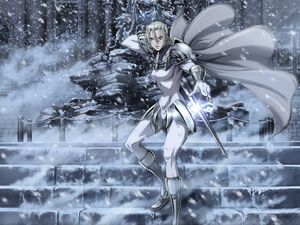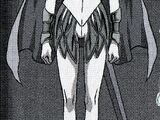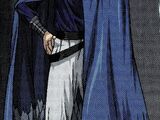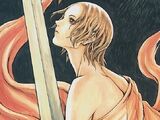| Claymore | |
|---|---|
 Jean, DVD sleeve front face | |
|
VIZ Media name |
Claymore[1] (en-us |
|
Variant |
Name: Claymore[2][3][4][5] (de |
|
Original name |
クレイモア[14] Kureimoa |
|
Rank No. |
1–47 |
|
Current status |
Extant |
|
Generations |
4 known and 4 eras |
|
Ties |
Organization |
|
Class |
Defensive, offensive and special types: Yoma power, agile, strength, mental and sensing abilities |
|
Technique |
Yoma power, agile, strength, mental, sensing |
|
Reports to |
Man in Black |
|
First appearance |
|
Etymology[]
Origin[]
Claymore derived from 18th century Scottish-Gaelic claidheamh mór (sword great). Claidheamh is pronounced "clave" and the earlier "glaive."
The "glaive" pronounciation derives from the Latin "gladius" (sword), which in turn derives from "Gaul," a Celtic people whose name is thought to mean "sword."
Usage in series[]
On the island world of Claymore, the public names the female warriors after their Claymore sword. Warriors are almost always half-Yoma, half-human.
"Yoma War Record I" refers to them as 戦士 senshi (warrior, soldier or combatant). According to Clare, "Claymore" is not used within Organization.[15]
Names[]
In medieval Europe, only first (christened) names were recognized by "God and Church." The real life "Joan of Arc" or "Jeanne d'Arc" only used "Jehanne" and never a last name. The Claymore universe appears to follow this custom.
But a warrior's name may be embellished with a moniker, derived from demeanor (Teresa of the Faint Smile), physical prowess (Muscular Sophia, Stormwind Noel), special technique (Quicksword Ilena, Windcutter Flora), modus operandi (Roxanne of Love and Hate).
Warrior names alone are striking:
- Actresses: Audrey, Deneve, Dietrich, Eva, Keira, Lena, Natalie
- Goddesses: Europa, Eva, Flora, Galatea, Minerva, Nina, Nike, Teresa, Undine
- Princesses: Alicia, Anastasia, Audrey, Cassandra, Claudia, Elizabeth, Helen, Ilena, Octavia, Renée
- Saints: Anastasia, Agatha, Clare, Helen, Jean, Elizabeth, Keira, Lucia, Matilda, Sophia, Teresa, Veronica
- Warriors: Elda, Hilda, Jean, Carla, Matilda, Nike, Zelda
Appearance[]
Uniform[]
Warriors wear a Roman army-like uniform, stylized in an Art Deco manner. It consists of gray shirt and leggings, with turtle-neck dicky marked with the warrior's symbol, which appears on the throat. Over this 2-piece suit warriors wear pieces of armor. The sword is sheathed in a carrier mounted on a metal plate sewn into the shirt between the shoulder blades. Over this ensemble a cape hangs from the carrier horns.
Despite a superficial resemblance, no two uniforms are identical. Details differ among the warriors' uniform. This may reflect difference in fighting techniques, or individual preference.
Physical[]
Human[]
Form[]
Stylized with Art Nouveau female forms and faces, Claymore warriors are human in appearance, except for silver eyes (yellow during Yoma Energy release) and occasional pointed ears.
A stigma,[16] an unhealable torso-length incision, is made during childhood to implant Yoma tissue throughout the body.[17]
Coloring[]
A common misconception is that Claymore warriors are albinos. True albinos have red eyes, not silver gray ones. There is usually some pigmentation in the skin and hair. Claymore skin complexion range from pale to albino-like. Pale blonde hair of various shades are done in various manga hairstyles, from pageboy to hime.
Size[]
Known height range: 165cm (5ft 4.96in)–185cm (6ft .83in). Known mode height: 175cm (5ft 8.89in).[18][19][20]
Awakened[]
In the early stages of awakening, warriors initially resemble Yoma, but soon develop into full-fledged awakened beings, which morph into an infinity of surrealistic shapes.
Datasheet[]
Baseline[]
 Organization rates each warrior on six baselines:
Organization rates each warrior on six baselines:
 Yoma power: Yoma energy potential
Yoma power: Yoma energy potential Agility: quickness, speed and maneuverability of body
Agility: quickness, speed and maneuverability of body Strength: muscular strength and extension (shapeshifting)
Strength: muscular strength and extension (shapeshifting) Mental: depth, discernment and quickness of thought
Mental: depth, discernment and quickness of thought Sensing: detecting Yoma power and discerning its qualities
Sensing: detecting Yoma power and discerning its qualities Leadership: directing group efforts, especially awakened hunts
Leadership: directing group efforts, especially awakened hunts
A warrior's experience increases effective use of baselines, resulting in improved performance of innate ability and technique.
These baselines also determine rank.
Class[]
"Class" combines type with ability.
Type[]
Corresponds with "personality."
Defensive personalities are the most egocentric—having the strongest will to live, they win by surviving.[21] Offensive personalities are less concerned about surviving than killing target.[22] Special is least egocentric—they have little or no sense of self and most obedient to Organization.[23]
Ability[]
Ability derives from the six baselines:
Technique[]
Technique may originate from—but is independent of—the five innate abilities and baselines.
Sometimes confused with innate abilities. Technique derives from baselines, personality type, innate ability and experience. While these four factors are important in originating technique, a technique, once established, can be learned by those with different baselines and abilities.
History[]
Trainees[]
Creation[]
- Phase 1: Yoma activity creates a large supply of orphans. But only females are suitable candidates for Yoma implants. Originally, warriors were male, but found unsuitable due to premature awakening.[24]
- Phase 2: An incision is made down the length of the trainee's torso—from the throat to the mons pubis. This incision never heals or closes. Sutures prevents the internal organs from spilling out.[25] Transformation is extremely painful, as long as transplant does not adapt to human body.[26] Results differ as fingerprints. A trainee can be ready at any age. Side-effects include eyes turning silver and original hair changing to light-blond. Warriors do not age after reaching adulthood.
- Phase 3: Trainees are taught to conduct covert operations, as well as combat skills. Final exam is actually fighting Yoma.
- Phase 4: When a trainee is ready, she is given an unique symbol to identify her. The warrior is then assigned to one of 47 districts on the island.[27]
Training[]
Starts at school. In the anime, the dormitory is prison-like. Roommates resemble cellmates.[28]
Beside combat skills, trainees learn to play civilian roles—ranging from an aristocrat to a prostitute.[29]
Few trainees survive final exam—possibly 80% fatality rate.[30]
Career as warrior[]
Rank[]
Ranks No. 1–47 assigned by levels of six power baselines and resulting performance.
5-region island further divided into 47 districts. On graduation, each warrior is assigned a district, corresponding to her number. It is assumed that a warrior is prepared to be reassigned anywhere at a moment's notice.[31]
Missions[]
 Seven types of missions:
Seven types of missions:
 Awakened hunt: mission involves a team effort to suppress Awakened Beings. Example: Paburo hunt.[32]
Awakened hunt: mission involves a team effort to suppress Awakened Beings. Example: Paburo hunt.[32] Black card: mission involves euthanizing a warrior before she awakens. Example: Elena and Clare.[33]
Black card: mission involves euthanizing a warrior before she awakens. Example: Elena and Clare.[33] Covert operation: mission involves impersonating ordinary humans to blend into the human population. Example: Clare posing as an antiques dealer in Rabona.[34]
Covert operation: mission involves impersonating ordinary humans to blend into the human population. Example: Clare posing as an antiques dealer in Rabona.[34] Purge: mission involves execution of warriors, either guilty of obedience or in danger of awakening. Example: Teresa.[35]
Purge: mission involves execution of warriors, either guilty of obedience or in danger of awakening. Example: Teresa.[35] Search and rescue: mission involves finding and retrieval of personnel. Example: Galatea in Witch's Maw.[36]
Search and rescue: mission involves finding and retrieval of personnel. Example: Galatea in Witch's Maw.[36] Surveillance: mission involves surveillance of warriors and Yoma entities. Assignee is the Organization Eyes. Example: Galatea in Paburo Mountains.[37]
Surveillance: mission involves surveillance of warriors and Yoma entities. Assignee is the Organization Eyes. Example: Galatea in Paburo Mountains.[37] Yoma suppression: mission is usually a solo assignment to eliminate Yoma. Example: Clare in Doga.[38]
Yoma suppression: mission is usually a solo assignment to eliminate Yoma. Example: Clare in Doga.[38]
Between missions[]
When warriors are not on a mission, they can move freely in their district, but they are always under surveillance. In most cases they bivouac in the remotest areas where they scrounge for food. Most warriors not lie down to sleep but normally take naps while leaning against one's sword stuck in the ground.[39]
Future[]
A warrior can look forward to a bleak future of:[40]
- Being killed in action
- Being object of purge (executed or assassinated)
- Giving one's black card to a sister warrior and be euthanized (before awakening)
- Awakening and being pursued by an awakened hunt.
Warriors respond differently to this fate. Some are stoic, like Clare. Or fatalistic like Elena. Others go insane like Ophelia. Some compensate by intimating humans (Teresa, Renée) or fellow warriors (Undine, Helen). A few, such as Galatea, Jean and Flora, appear to overcome their tragedy.
Generations[]
Known chronological order[]
- (Initial Male Era)
- First Generation
- Riful Era
- Old Generation
- Luciela Era
- Teresa Era
- Current Generation
- Next Generation
Also see article on Generation.
References[]
Tankōbon Claymore volumes cited are VIZ Media (en-us) editions, unless otherwise noted. Manga scenes (chapters) not yet translated cite Shueisha tankōbon (ja) editions. Manga scenes not yet published in tankōbon form cite Jump SQ (ja) editions. Fragments of Silver Omnibus (総集編 銀の断章 Gin no Danshou) 1–3, Shueisha, are only available in Japanese. Anime scenes (episodes) cited are FUNimation (en-us) editions, unless otherwise noted.
- ↑ Claymore 1, Scene 1, p. 12
- ↑ Claymore 1, Tokyopop, Scene 1, p. 12
- ↑ Claymore 1, Ediciones Glénat España, Scene 1, p. 12
- ↑ Claymore 1, Glénat Édition Française, Scene 1, p. 12
- ↑ Claymore 1, Star Comics, Scene 1, p. 12
- ↑ Claymore 1, Comix-ART, Scene 1, p. 12
- ↑ Claymore 1, Culturecom, Scene 1, p. 12
- ↑ Claymore 1, Shueisha, Scene 1, p. 17
- ↑ Claymore 1, Scene 1, p. 17
- ↑ Claymore 1, Shueisha, Scene 1, p. 17
- ↑ Claymore 1, Scene 1, p. 17
- ↑ Claymore 1, Scene 1, p. 16
- ↑ Fragments of Silver 1, "Yoma War Record I, p. 498
- ↑ Claymore 1, Shueisha, Scene 1, p. 12
- ↑ Claymore 1, Scene 1, p. ; Anime Scene 1
- ↑ Claymore 15, Scene 82, p. 148
- ↑ Jump SQ, September 2012, Claymore, Scene 129, pp. 651–655
- ↑ Fragments of Silver Omnibus 1, "Yoma War Record I," pp. 506, 508, 510, 512, 513, 514, 515
- ↑ Fragments of Silver Omnibus 2, "Yoma War Record II," pp. 684, 686, 687, 688, 689
- ↑ Fragments of Silver Omnibus 3, "Yoma War Record III," pp. 724, 725, 726, 727, 729
- ↑ Claymore 7, Scene 35, p. 62
- ↑ Claymore 7, Scene 35, p. 62
- ↑ Claymore 11, Scene 62, p. 145
- ↑ Fragments of Silver 1, "Yoma War Record I," p. 501
- ↑ Jump SQ, September 2012, Claymore, Scene 129, pp. 651–655
- ↑ Fragments of Silver 1, "Yoma War Record I," p. 501
- ↑ Fragments of Silver 1, "Yoma War Record I," p. 501
- ↑ Claymore, Anime Scene 2
- ↑ Fragments of Silver Omnibus 1, "Yoma War Record I," p. 501
- ↑ Claymore 14, Extra Scene 4, p. 180
- ↑ Fragments of Silver 1, "Yoma War Record I," p. 501
- ↑ Claymore 5, Scene 25, p. 127; Claymore, Anime Scene 9
- ↑ Claymore 1, Scene 4, pp. 170–172; Claymore, Anime Scene 2
- ↑ Claymore 2, Scene 5, pp. 8–10; Claymore, Anime Scene 3
- ↑ Claymore 4, Scene 17, p. 86; Claymore, Anime Scene 6
- ↑ Claymore 8, Scene 43, p. 133; Claymore, Anime Scene 16
- ↑ Claymore 6, Scene 30, p. 80; Anime Scene 10
- ↑ Claymore 1, Scene 1, p. 18; Anime Scene 1
- ↑ Fragments of Silver 1, "Yoma War Record I," p. 502
- ↑ Fragments of Silver 3, "Yoma War Record III, p. 735
All items (122)












































































































































